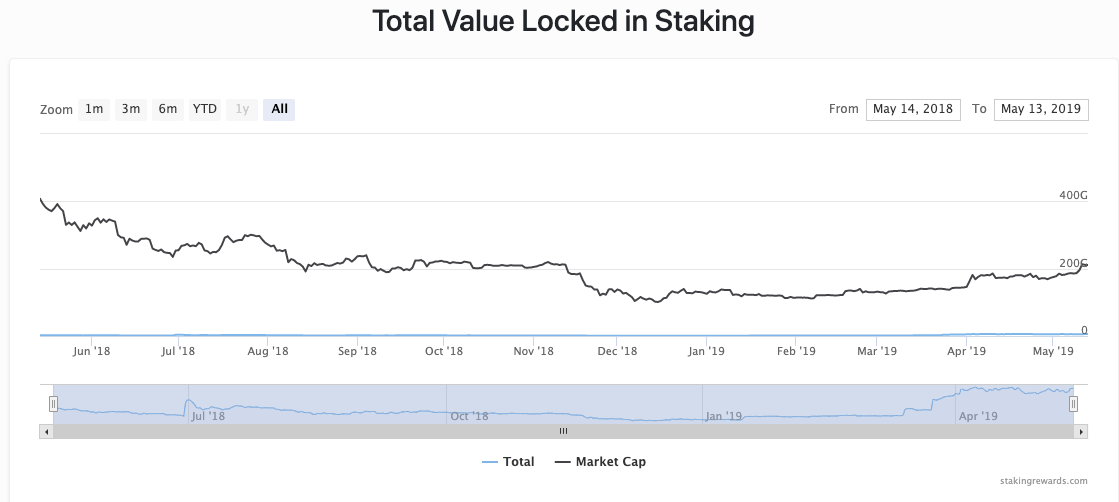markdown pos staking专题
Posted
tags:
篇首语:本文由小常识网(cha138.com)小编为大家整理,主要介绍了markdown pos staking专题相关的知识,希望对你有一定的参考价值。
here is about pos staking topic.# 各POS项目相关数据概览
> 来自[Proof of Stake 第一期周报](https://mp.weixin.qq.com/s/q9-3kRp9VBG-51f0B4xDyw)
State of Staking Economy 各网络已质押加密货币市值一览


> 图表来源 https://stakingrewards.com/global-charts
## 项目市值一览

> 图表来源: https://www.coingecko.com
# POS整体介绍
> from : https://mp.weixin.qq.com/s/Z7yAdMBkIYTZKBpHcRaWvw
## 当前的主流共识算法
PoW(Proof of Work工作量证明),PoS(Proof of Stake 股权证明机制),BFT (拜占庭容错机制),混合共识等,还有一些从主流基础上演变出来的共识算法,诸如PoA(Proof of Authorization授权证明机制),PoI(Proof of Importance重要性证明机制),DPoS (Delegate Proof of Stake股权证明机制),PBFT(Practical Byzantine Fault Tolerance实用拜占庭容错算法)
其中PoS是主流里的主角, 以太坊也计划从PoW转到PoS共识。
## 什么是PoS共识、定义
V神在《Casper the Friendly Finality Gadget》blog中的定义
> In a PoS system, a blockchain appends and agrees on new blocks through a process where anyone who holds coins inside of the system can participate, and the influence an agent has is proportional to the number of coins (or ‘stake’) it holds. This is a vastly more efficient alternative to PoW‘mining’ and enables blockchains to operate without mining’s high hardware and electricity costs.
通过持币来投票质押, 不需要花费电力和高性能硬件。
## PoS的过程
持币人将代币进行staking从而获得出块的机会, 然后通过选举算法, 按照持币的比例选出出块的旷工, 之后生成新区块并广播, 广播的区块经过PoS中的另一个步骤: 验证, 通过验证后区块便得到确认, 完成。
## 共识趋势
未来十年PoW会趋向减少, PoS趋向增多。
2017年ICO融资PoS比例占30%, PoW占5%
2017年ICO融资情况

2018年ICO融资情况

# cosmos和波卡的区别
> from here: https://staked.substack.com/p/seeking-yield-by-staked-issue-13
### **5 Differences between Cosmos & Polkadot**
Julian Koh recently published an extremely comprehensive article highlighting five key differences between Cosmos and Polkadot. According to the piece:
**Advantages of Polkadot over Cosmos:**
1. Application developers do not need to bootstrap their own security
2. If they can solve data availability, interchain messaging under shared security is easier
3. They seem to be more ambitious with Substrate (WASM, more consensus algorithms & modules out-of-the-box)
4. Focus on arbitrary message passing better for cross-parachain contract calls. (Still unsure of use case today)
5. Seems to have more developers building version 1.0
**Advantages of Cosmos over Polkadot:**
1. Cosmos is live. Polkadot is not.
2. Polkadot has a restrictive & possibly expensive parachain membership process
3. More customizability is better for specific projects (e.g, Binance)
4. Evil validators of parachains could spread corruption throughout entire network. Cosmos restricts corruption to only within the zone & corresponding assets
5. Cosmos SDK used by many projects already
6. Focus on asset transfers simpler & easier to get right. Proven use case today
> 详细链接见 [这里](https://medium.com/@juliankoh/5-differences-between-cosmos-polkadot-67f09535594b)以上是关于markdown pos staking专题的主要内容,如果未能解决你的问题,请参考以下文章